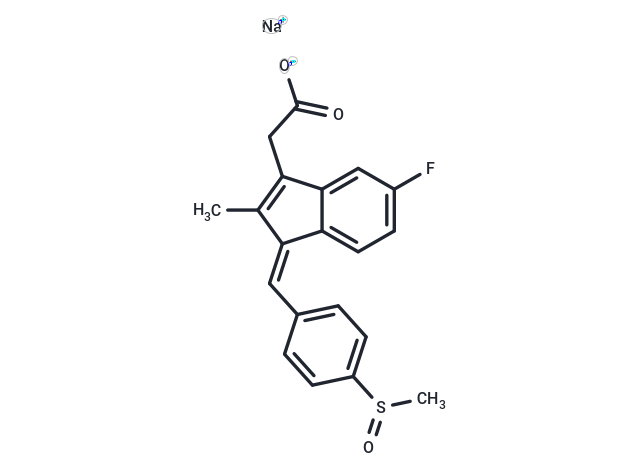 Your shopping cart is currently empty
Your shopping cart is currently empty

Sulindac (sodium) (MK-231) is an orally active nonsteroidal anti-inflammatory agent. Sulindac (sodium) is used to reduce pain, swelling, and joint stiffness from arthritis. Sulindac is also used for the research of arthritis of the spine, gouty arthritis. Sulindac (sodium), as an immunomodulatory agent, can downregulate PD-L1 through the blockade of NF-κB signaling and modulates the response of pMMR colorectal cancer (CRC) to anti-PD-L1 immunotherapy, inhibits the development and progression of colorectal cancer CRC. Sulindac (sodium) also inhibits TGF-β1- induced epithelial-mesenchymal transition (EMT) and suppresses lung cancer cell migration and invasion via downregulation of SIRT1 [1] [2].

| Pack Size | Price | USA Warehouse | Global Warehouse | Quantity |
|---|---|---|---|---|
| 25 mg | $1,520 | 1-2 weeks | 1-2 weeks | |
| 50 mg | $1,980 | 1-2 weeks | 1-2 weeks | |
| 100 mg | $2,500 | 1-2 weeks | 1-2 weeks |
| Description | Sulindac (sodium) (MK-231) is an orally active nonsteroidal anti-inflammatory agent. Sulindac (sodium) is used to reduce pain, swelling, and joint stiffness from arthritis. Sulindac is also used for the research of arthritis of the spine, gouty arthritis. Sulindac (sodium), as an immunomodulatory agent, can downregulate PD-L1 through the blockade of NF-κB signaling and modulates the response of pMMR colorectal cancer (CRC) to anti-PD-L1 immunotherapy, inhibits the development and progression of colorectal cancer CRC. Sulindac (sodium) also inhibits TGF-β1- induced epithelial-mesenchymal transition (EMT) and suppresses lung cancer cell migration and invasion via downregulation of SIRT1 [1] [2]. |
| In vitro | Sulindac (sodium) (MK-231 (sodium)) effectively counteracts TGF-β1-induced epithelial-mesenchymal transition (EMT), as demonstrated by the upregulation of the epithelial marker E-cadherin and the downregulation of mesenchymal markers and transcription factors. It also inhibits the TGF-β1-enhanced migration and invasion of A549 cells. The modulation of SIRT1 levels plays a crucial role, where its downregulation enhances sulindac’s (sodium) effectiveness in reversing TGF-β1-induced EMT, while its upregulation promotes this process. Western Blot Analysis and Immunofluorescence studies, conducted on A549 cells treated with 500 μM of sulindac (sodium) for 48 hours, showed inhibition of TGF-β1-induced EMT and a reversal of SIRT-1 expression influenced by TGF-β1, including an inhibited cadherin switch. Additionally, Cell Migration and Invasion Assays revealed that sulindac (sodium) treatment reduced cell migration and effectively decreased the TGF-β1-induced increase in cell invasion, highlighting its potential as a therapeutic agent against lung cancer progression. |
| In vivo | Sulindac (sodium) (MK-231 (sodium)), administered orally at doses of 15 mg/kg alone and 7.5 mg/kg in combination with PD-L1 blockade twice daily, was found to significantly decrease tumor volume and enhance CD8+ T lymphocyte infiltration in tumor tissues in a CT26 syngeneic mouse tumor model. The combination therapy notably downregulated Programmed Death-Ligand 1 (PD-L1) by inhibiting NF-κB signaling, leading to a reduction in exosomal P and increasing the availability of PD-L1 antibodies. Despite these effects, Sulindac (sodium) (MK-231 (sodium)) at low doses did not exhibit a systemic inhibitory impact on prostaglandin E2 (PGE2). This indicates Sulindac’s potential to modulate the response of pMMR colorectal cancer (CRC) to anti-PD-L1 immunotherapy without significant systemic toxicity. |
| Molecular Weight | 378.39 |
| Formula | C20H16FNaO3S |
| Cas No. | 63804-15-9 |
| Smiles | [Na+].CC1=C(CC([O-])=O)c2cc(F)ccc2\C1=C/c1ccc(cc1)S(C)=O |
| Storage | Powder: -20°C for 3 years | In solvent: -80°C for 1 year | Shipping with blue ice/Shipping at ambient temperature. |
| Size | Quantity | Unit Price | Amount | Operation |
|---|

Copyright © 2015-2026 TargetMol Chemicals Inc. All Rights Reserved.